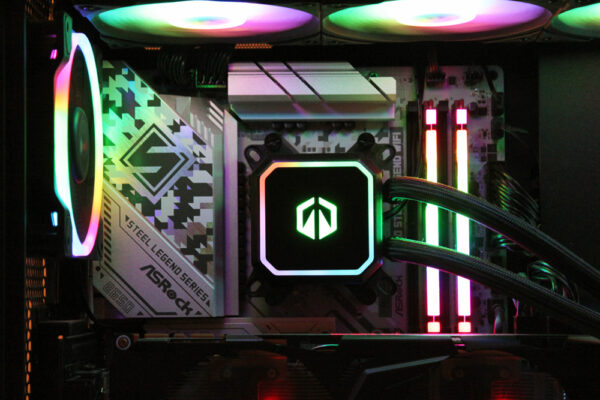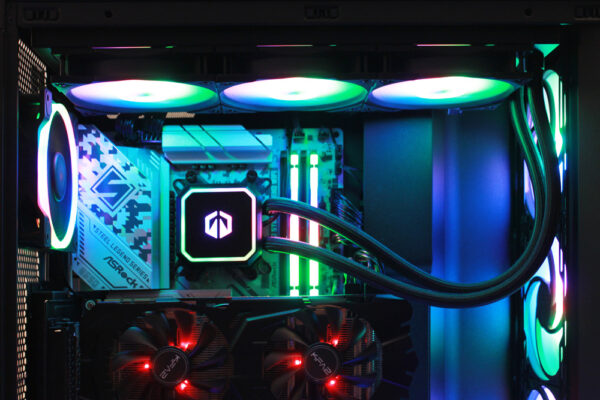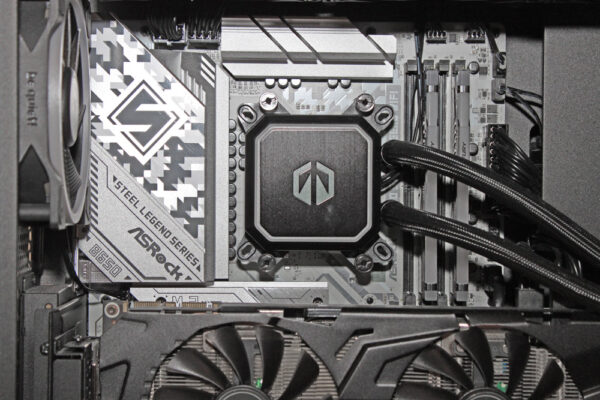
Test setup and results …
To test the Endorfy Navis F360, we use our AMD AM5 test system, which consists of the following components.
| Motherboard | ASRock B650 Steel Legend WiFi |
| CPU | AMD Ryzen 7 7700 |
| RAM | Kingston Fury RGB 2x 16GB DDR5-6000 |
| PSU | NZXT C1500 ATX 3.1 |
| Graphics card | KFA2 GTX 1070 |
| Case | NZXT H7 Flow RGB 2024 |
| Betriebssystem | Windows 11 23H2 |
Performance test with Prime95 …
To test the performance of the Endorfy Navis F360 under maximum load, the AMD Ryzen 7 7700 was overclocked to 120W. The stress test was carried out with Prime95 in Small FFTs mode, as this is designed to generate the maximum heat development of a CPU. Each test phase ran for ten minutes to ensure that the temperatures stabilized. The pump ran at 100% power throughout the test.
Test results and temperature behavior …
The Endorfy Navis F360 naturally shows its strengths above all in comparison to air coolers. Although it is more expensive to purchase, the difference is particularly noticeable at low fan speeds. While air coolers reach their limits at low speeds, the AIO cooler was able to keep the CPU temperature constant at a maximum of 82°C – and at an almost inaudible fan speed of just 500 revolutions per minute.
Even at higher speeds, the Endorfy Navis F360 proved its superiority over air coolers. The temperature advantage was always at least 3°C. A further improvement in cooling performance would have been possible if the radiator had been mounted on the front of the case, as this would have used cooler air and not air already heated by the GPU.
Users who do not want to adjust their fan control manually also benefit from the AIO. When using the predefined “Silent” fan profile, the cooling remained more efficient than conventional air coolers. The fans ran at 1100-1500 rpm compared to the 1200-1700 rpm of air cooling and remained only slightly audible even under load. The average CPU temperature in this scenario was 69°C, while the Arctic air cooler reached 72°C.
The Endorfy Navis F360 impresses with its excellent cooling performance, especially in comparison to air coolers. It keeps temperatures stable even at low fan speeds and always offers a head start of at least 3°C.

Temperatures Arctic Freezer 36 ARGB …
| PWM percentage | Fan speed | Average temperature in °C | Maximum temperature in °C |
| 25 | 500 | 90 (max. Temp. nach 3 min) | 90 (max. Temp. nach 3 min) |
| 50 | 1000 | 75 | 83 |
| 75 | 1500 | 72 | 78 |
| 100 | 1900 | 71 | 77 |
| Silentprofile | 1200-1700 | 72 | 77 |
Temperatures Endorfy Navis F360 …
| PWM percentage | Fan speed | Average temperature in °C | Maximum temperature in °C |
| 20 | 500 | 79 | 82 |
| 25 | 625 | 76 | 78 |
| 40 | 1000 | 72 | 75 |
| 70 | 1500 | 69 | 74 |
| 100 | 1900 | 68 | 73 |
| Silentprofile | 1100-1500 | 69 | 74 |
Volume …
The noise level is a decisive factor for many users, especially for those who prefer a quiet system. In normal operation at low speed, the fans are almost inaudible, which is a particular advantage for silent PC enthusiasts. Even under load, the noise development remains pleasantly low.
At maximum speed, the fans are clearly audible, but not disturbing. Only the airflow is audible, the bearing noises are not perceptible. The pump also operates at full power with a barely audible frequency, so that it is not noticeable in everyday operation.
Cooling remains efficient and quiet, especially in combination with predefined fan profiles. With automatic control, the fan speeds are adjusted to achieve an optimum compromise between cooling performance and noise development. This makes the Endorfy Navis F360 particularly suitable for users who value strong cooling performance with minimal background noise.

Endorfy Navis F360 lighting …



